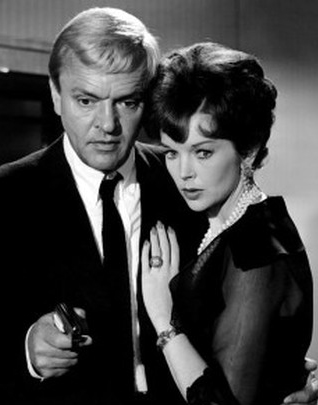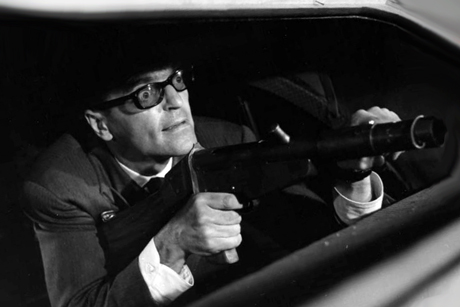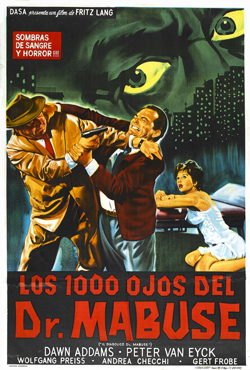| Release List | Reviews | Price Search | Shop | Newsletter | Forum | DVD Giveaways | Blu-Ray/ HD DVD | Advertise |
| Reviews & Columns |
|
Reviews DVD TV on DVD Blu-ray International DVDs Theatrical Reviews by Studio Video Games Features Collector Series DVDs Easter Egg Database Interviews DVD Talk TV DVD Talk Radio Feature Articles Columns Anime Talk DVD Savant HD Talk Horror DVDs Silent DVD
|
DVD Talk Forum |
|
|
| Resources |
|
DVD Price Search Customer Service #'s RCE Info Links |
|
Columns
|
 |
The 1,000 Eyes of Dr. Mabuse
|
||||
As far as Savant is concerned, the Big DVD this year isn't Independence Day or Jurassic Park or any of the perfectly wonderful discs coming out by the dozens each month: It's a little German film from the tiny (but fertile) All Day Entertainment label, a 1960 thriller that wasn't even released in America when it was new. The 1,000 Eyes of Dr. Mabuse is Fritz Lang's swansong. After a series of clever films noir for RKO, the legendary director returned to West Germany to make only three more films: a two-part remake of a 1920s adventure story set in India, and this return to both the subject and style of the last film he made before fleeing Germany in 1933: Doctor Mabuse. 
Lang had to be pressured into 'reviving' his legendary arch-criminal Mabuse, originally the villain of a pair of bizarre silent films made back in 1922. In them, Lang and scenarist Thea von Harbou captured the feel of the crazy post-WW1 German psycho-scape, a time of political and economic unrest that had sent a nervous society searching for a cause. Lang gave them Mabuse, a hypnotist-gangster-conspiratorial madman who stole patents and government secrets, blackmailed millionaires, manipulated stock markets and murdered at will, all in the name of chaos. At the windup, he was locked Mabuse away in an asylum; ten years later the imprisoned maniac returned in The Testament of Dr. Mabuse, where he filled hundreds of pages with feverish handwritten criminal schemes. Through hypnosis, Mabuse possessed the asylum director and forced him by psychic remote control to carry out his deranged but brilliantly fiendish plans. Testament (1932) later became famous for its anti-Nazi sentiments; when dubbed into English Mabuse's vicious speeches were spiked with recognizable Hitler phraseology. Lang's quartet of Mabuse films span more cinema history than any other pulp thriller series. The first silent films were the contemporaries of Judex and Fantomas, and the all-talkie Testament outdid American gangster films with its overarching conspiracy theme. For his 1960 comeback, Lang pushed the limits of movie thrillers even further. Reaching beyond the tame espionage tales of the time, The 1,000 Eyes of Dr. Mabuse anticipated the Science Fiction adventures of James Bond, and the political paranoia of The Parallax View. It especially predicts the technological subgenre (The Anderson Tapes, The Rising Sun, End of Violence, Death Watch, Until the End of the World) that indicts pernicious surveillance as the key to totalitarian domination, the threat to psychological liberty. 1,000 Eyes begins with a clever updating of one of classic scenes from Testament (later saluted in The Ipcress File). In Berlin, Inspector Kras (Goldfinger's Gert Frobe) investigates the murder of television anchorman Peter Barter, slain with an experimental silent gun. A creepy blind psychic named Cornelius (Lupo Prezzo) predicts the killing and insists that similar danger awaits visiting American billionaire Henry B. Travers (Peter Van Eyck), who is trying to close a deal to purchase the Taran Atomic works, and build nuclear Rockets. At the Luxor Hotel, events and characters pile up at a frantic rate as Travers falls into a relationship with the beautiful Marion Menil (Dawn Addams), whom he rescues from a ledge on the 14th floor. Her psychiatrist Dr. Jordan (Wolfgang Preiss) is shielding her from a fearfully abusive husband. Carrying out the murderous orders of the unseen Mabuse is "Number 12" (Howard Vernon of The Awful Dr. Orlof), an ice-cold assassin who prowls about in a car with (like 007's Aston Martin) revolving license plates. A busybody insurance investigator with the ridiculous name of Hieronymous Balthazar Mistelsweig (Werner Peters) is sticking his nose into everyone's business; especially Henry's. Fearing for Marion's well being, Travers is invited by the Luxor's sleazy house detective (Andrea Checci of Black Sunday) into a secret chamber with a one-way mirror that looks into Marion's room. Travers at first objects, but cannot resist watching Marion dress. As the bizarre events multiply to a seemingly unexplainable level of complexity, the outlines of Mabuse's greatest conspiracy begin to take shape. The 1,000 Eyes of Dr. Mabuse returns to the exciting style Fritz Lang developed in both "M" and the 1932 Testament. Lang overlaps whole scenes in the same way that actors sometimes overlap dialogue; verbal cues are positioned to motivate rapid-fire scene changes that would otherwise be jarring and illogical. In "M", if a policeman ends a sentence with, "... we must find this MURDERER!" the image would cut on the last word to the shadow of child-killer Peter Lorre on a wall. The moment a new element is introduced, the film cuts to that new element: a character, a place, an object. 
Lang also uses his gimmick of having a speech delivered in one scene continued by someone completely unrelated in the next. Two unrelated conversations are cut together, with the 'incoming' speaker answering or commenting on dialog from another location entirely. These techniques are difficult to describe but in the movie itself are immediately intuitive. The film is a mystery puzzle where the audience participates directly in Lang's 'filmic architecture'. The effect is a nervous forward momentum. 1,000 Eyes breaks a complicated mystery down into dozens of short, interlocking scenes. Each scene introduces only a single puzzle piece for the mystery. It's as if each little scene has the verb for the scene that precedes it, and the noun for the scene that follows. We the viewers must digest the flood of un-collated information as fast as we can. The assassin No 12 chides his driver for wanting to see Mabuse's face ("That's like ordering your own coffin") and reminds him of an American who was found with his throat cut. Two rapid scene changes later, the German cops are pondering an American soldier found with his throat cut, who stole blueprints for the secret U.S. mystery weapon. There must be at least two or three of these links every minute, so just keeping track of them is exciting in itself! Savant saw The 1,000 Eyes of Dr. Mabuse cold in 1980 and is grateful not to have had the experience spoiled. The worst thing a review could do, would be to detail the plot or get specific about the wealth of pulp themes that burst forth. This film and the Hammer science fiction epic Quatermass 2 are for Savant the missing links between pre- and post- James Bond pop cinema; after seeing 1,000 Eyes Savant feverishly scribbled out a chain of themes that link Feuillade serials to German expressionist thrillers to gangster movies to film noir to apocalyptic thrillers to Batman camp to totalitarian political conspiracies ... and finally to superspy films. Many scholars place importance in the silent Mabuse because just a few years later a megalomaniac criminal with a warped philosophy did indeed take over Germany and plunge the world into chaos. Lang's 1960 update incorporates the techno-terror advances of the Nazis through the prophetic theme of remote-control surveillance. Just as Lang invented the language of espionage films with his 1928Spione, the source of Mabuse's sinister new power is incredibly prophetic -- echoing through dozens of voyeuristic spy flicks and resonating eerily through today's Orwellian nightmare entertainments: The Truman Show, even television's Survivors. To cite just one instance, the hotel one-way mirror sequence implicates viewers that want to see Marion Menil undress, encapsulizing in just a few seconds the theme of the cinema-literate Peeping Tom. Who is the real voyeur? Who is being deceived, and by whom?  The accumulated awareness of forty additional years of spy gimmicks and alienation techniques only makes this original film all the more fascinating. There is no central superspy character (well, not exactly...), and no one in the cast, including the dogged cop played so well by Gert Frobe is made to act stupidly to keep the mystery afloat. The only party given enough facts to pull the story together is the viewer. The revelations are carefully timed. Just as the puzzle is taking shape, the film leaps from suspense mode into the high gear of an action film. The 1,000 Eyes of Dr. Mabuse ends with a crackling action set piece that integrates all of its crazy subplots. But the real capper is the final revelation of Mabuse's core motivation. The original silent Mabuse saw Chaos as its own end and Lang's update ups the ante to its logical 1960 level -- nuclear annihilation. Lang knows that any meaningful struggle can no longer be fought for petty stakes. Like Kiss Me Deadly before it, 1,000 Eyes knows that quaint 'McGuffins' will no longer do. Now the fate of the world must hang in the balance. In prepping this disc review, Savant has been writing and then deleting whole paragraphs of spoiler-inducing praise and counterproductive oversell. Some viewers will judge 1,000 Eyes as a talky and confusing thriller that doesn't fall into any category. Heck, it's got an old-fashioned séance scene, and its big chase wasn't filmed with the coolest cars on the Autobahn, Fritz. But have no fear... see The 1,000 Eyes of Dr. Mabuse with an open mind and it will make today's action movies seem feeble. After dutifully presenting excellent editions of interesting pix thought lost or mangled (The Asphyx, Ganja & Hess), All Day has done it right with a bona fide classic desperately in need of reintroduction to the world. The 1,000 Eyes of Dr. Mabuse has been transferred in a largely excellent enhanced B&W. The picture is fine and crisp until the final minutes or so, which switch to a clean but softer source. This flaw doesn't harm the impact of the finale, but is still a disappointment considering how absolutely perfect the rest of Mabuse looks. The original materials must have had a damaged reel. 
The 16mm prints available until now have all had an atrocious English voice-dubbing job that made some characters seem comical and the film cartoonish, like a Toho Science Fiction film. All Day has retained the excellent original German soundtrack. We get to hear Gert Frobe mit der Deutsche sprechen! It's still a good idea for non-German speakers to pay close attention, because, as in "M", listening to the dialogue and reading the subtitles while keeping track of the tricky editing is quite a workout. The English dub track isn't recommended but is there for folk that simply can't abide subtitles. An informative commentary by David Kalat provides a wealth of insight on Mabuse the legend and 1,000 Eyes the production. For extras, there is a selection of posters and trailers for the English-language versions of the '60s Mabuse films. Producer Brauner extended 1,000 Eyes into a whole new Crimi- influenced series, without Fritz Lang, including a 1962 Testament of Dr. Mabuse remake. (A companion All Day DVD combines both this film and the U.S. dubbed version of the 1932 original). The ads and trailers are so poorly written and edited, it's no wonder the series found few bookings in the U.S. The disc also contains a featurette, a very loose assemblage of interviews with Lang associates and film reviewers. Some of the information is good, like one spokesman's believable discrediting of the apocryphal 'fleeing Goebbels before the banks close" story about Lang leaving Germany. Savant has heard that tale attributed verbatim for Douglas Sirk and Billy Wilder as well. But a lot of the interview footage is unfocused and badly chosen. Fritz Lang's friend Forrest Ackerman is put in a bad light when he's allowed to relate a dubious anecdote about selfless altruism. It turns out to be awkward fluff about Forrest's own selfless altruism. I was tempted in this review to tell the entire plot and show off by pointing out the dozens of great original ideas and associations I've seen in The 1,000 Eyes of Dr. Mabuse. But this is one film that needs to be seen as unspoiled as possible, so this time Savant will settle for being selflessly altruistic. All Day's Mr. Kalat is coming out with a book of his own on the Mabuse phenomenon, which will hopefully organize all the brain-boggling excitement in relation to the rest of the '60s series. Savant will be foisting this disc on any friend or fan luckless (lucky?) enough to get within earshot. May All Day become obscenely successful and continue bringing out more gems like this one.
On a scale of Excellent, Good, Fair, and Poor, The 1,000 Eyes of Dr. Mabuse rates:

Review Staff | About DVD Talk | Newsletter Subscribe | Join DVD Talk Forum |
|
| Release List | Reviews | Price Search | Shop | SUBSCRIBE | Forum | DVD Giveaways | Blu-Ray/ HD DVD | Advertise |






